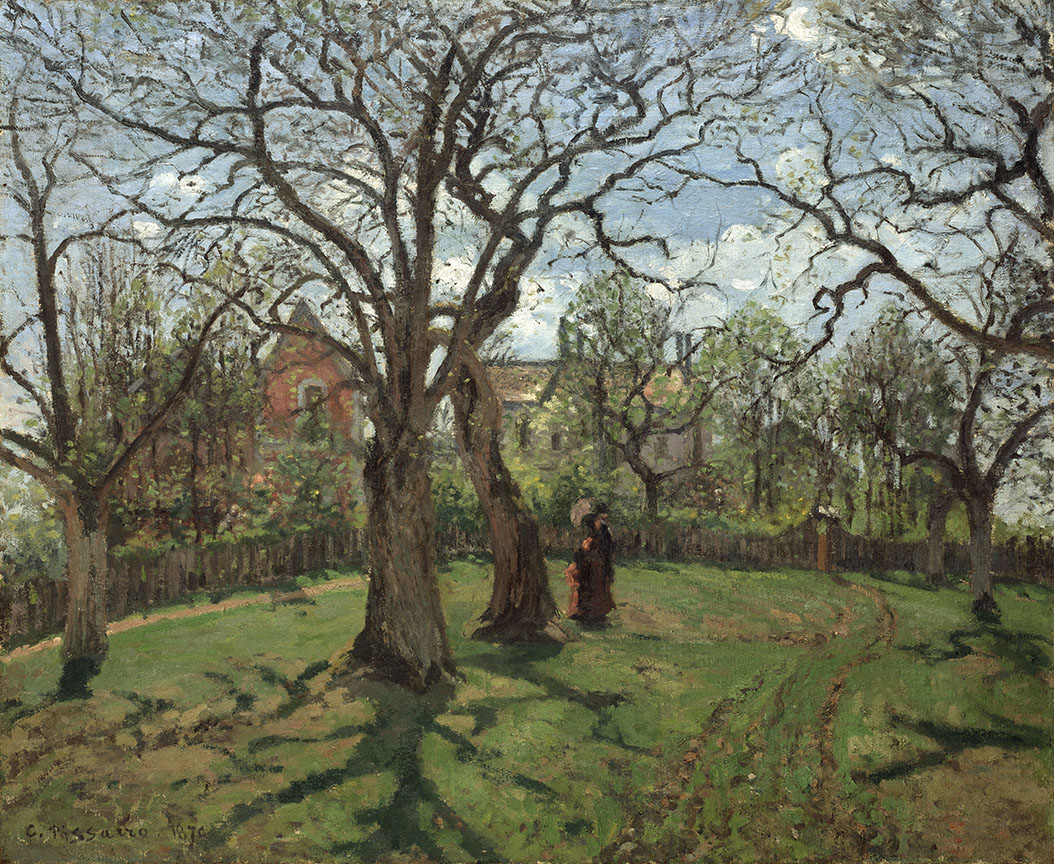The skeletons of trees and branches are still rising, bare and bony, into the pleasant spring sky, as if several hands at once were trying to seize the first warmth, in order to finally free themselves from the freeze of winter. The vibrancy of the twigs against the sky corresponds with the grasping shadows on the ground, which are still more gouty and ghostly than the hands above and appear to have seized the first life energy from the faint greenness. The backlighting from the invisible sun reinforces the contrast and effectively heightens the drama of the scene. The picture’s energetic composition almost makes us overlook the couple, with their parasol and top hat, who are standing together. These figures are almost fused into a uniform silhouette that resembles the broad tree trunks, an effect heightened by the backlighting and the brown-gray of their clothing. From a distance, one might almost mistake them for a tree trunk.
The location is of less importance to our understanding of the picture that one might think. Louveciennes, a small town to the west of Paris, was, at the time when this picture was painted, Pissarro’s hometown. This park, with its impressive planting of old chestnut trees, offered the artist a variety of favored motifs. As is so often the case with Impressionism, however, the heart of the picture does not lie in topographical identifiability, but in a freedom-loving self-sufficiency of the elements of painting. The motif — in this case the park and its chestnut trees— was to some extent the “occasion” for developing a new concept of painting (admittedly, one that was not understood by the public or even by the art experts of the time). What Pissarro explores in this picture is nothing less than a plumbing of the possibilities of using the effects of (back) light to release a sense of vibrant, flickering movement that embraces the whole picture. The violent thrashing of the branches underlies a delicate flickering of green leaves, together with the first blossoms in the background. In some places, buildings gently glimmer through the leaves. A continuous fence holds back the multifarious sparkling color, arcing like the horizon line of a small and yet vast world. Delicate rose, red, and green tones enhance one another’s effects in accordance with the physical laws of complementary contrast, creating flickering movement within small spaces.
Thus, spring is the subject matter of the picture, but it is also a metaphor for an awakening in painting. One can barely see the lightning in the sky of this spring day, but, in the wider sense, it is fully underway in the form of a violent shaking in the brown-gray flicker of the branches and of their shadows. It is not only the surface of the picture that is powerfully shaken up by these bare branches, but also the seeing habits of its epoch.
Markus Stegmann in: «Herzkammer», Museum Langmatt 2020
